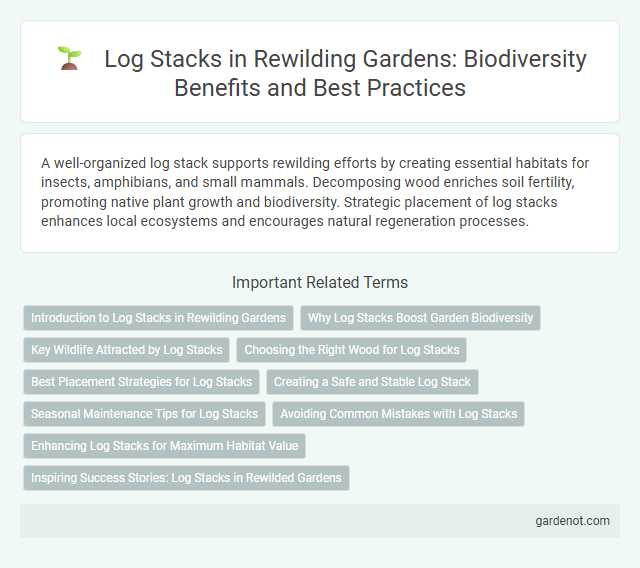A well-organized log stack supports rewilding efforts by creating essential habitats for insects, amphibians, and small mammals. Decomposing wood enriches soil fertility, promoting native plant growth and biodiversity. Strategic placement of log stacks enhances local ecosystems and encourages natural regeneration processes.
Introduction to Log Stacks in Rewilding Gardens
Log stacks serve as essential microhabitats within rewilding gardens, providing shelter and breeding grounds for insects, amphibians, and small mammals. Their natural decomposition enriches soil fertility, promoting biodiversity and enhancing ecosystem resilience. Strategically placing log stacks mimics natural woodland processes, supporting the rewilding goals of restoring native wildlife and balanced habitats.
Why Log Stacks Boost Garden Biodiversity
Log stacks create diverse microhabitats essential for various insects, fungi, and small mammals, enhancing overall garden biodiversity. They provide shelter, breeding grounds, and food sources that support ecosystem health and resilience. Incorporating log stacks into garden rewilding efforts fosters natural pest control and nutrient cycling, promoting sustainable growth.
Key Wildlife Attracted by Log Stacks
Log stacks provide essential habitats for various key wildlife species, including amphibians like newts and frogs, small mammals such as hedgehogs and shrews, and numerous invertebrates like beetles and spiders. These structures offer shelter, breeding sites, and foraging opportunities, supporting biodiversity and ecological balance in rewilding projects. By mimicking natural decay processes, log stacks create microhabitats crucial for fungi and decomposer species that drive nutrient cycling.
Choosing the Right Wood for Log Stacks
Selecting hardwoods like oak, ash, or beech for log stacks ensures durable habitats for wildlife and slow decomposition that supports biodiversity. Avoid treated or softwoods, as they degrade quickly and may release harmful chemicals, reducing ecological benefits. Properly chosen wood enhances microhabitats for insects, fungi, and small mammals critical to rewilding projects.
Best Placement Strategies for Log Stacks
Optimal placement of log stacks in rewilding projects prioritizes shaded, moist areas near water sources to support amphibians and invertebrates. Positioning logs partially buried or in contact with soil enhances microhabitats by retaining moisture and promoting fungal growth. Spatial distribution should avoid clustering to maximize habitat diversity and connectivity for species movement.
Creating a Safe and Stable Log Stack
Creating a safe and stable log stack in rewilding enhances habitat complexity by providing shelter for insects, small mammals, and amphibians. Proper stacking techniques ensure airflow and prevent moisture buildup, reducing rot and extending the lifespan of the wood in natural ecosystems. A secure log stack supports biodiversity and contributes to soil health by facilitating nutrient cycling and organic matter decomposition.
Seasonal Maintenance Tips for Log Stacks
Log stacks require seasonal maintenance to prevent moisture buildup and promote habitat for beneficial insects. Regularly rotate logs in spring and fall to enhance air circulation and reduce mold growth. Clearing surrounding debris during winter ensures the stack remains dry and supports diverse wildlife throughout the year.
Avoiding Common Mistakes with Log Stacks
Properly constructed log stacks enhance habitat complexity by providing shelter and food sources for insects and small mammals. Avoid common mistakes such as stacking logs too tightly, which restricts airflow and accelerates decay, or placing logs directly on soil without a base, increasing moisture retention and fungal growth. Maintaining varied log sizes and orientation fosters beneficial microhabitats essential for successful rewilding projects.
Enhancing Log Stacks for Maximum Habitat Value
Enhancing log stacks involves strategically arranging diverse-sized logs to create microhabitats that support a wide range of species, including insects, amphibians, and small mammals. Incorporating decayed wood and positioning stacks near water sources or native vegetation boosts moisture retention and nutrient cycling, fostering richer biodiversity. Properly designed log stacks can serve as critical refuges and breeding grounds, significantly increasing the ecological value of rewilding projects.
Inspiring Success Stories: Log Stacks in Rewilded Gardens
Log stacks in rewilded gardens serve as vital habitats for insects, amphibians, and small mammals, enhancing local biodiversity by providing shelter and breeding grounds. Successful projects show increased populations of beneficial species like beetles and hedgehogs, demonstrating the ecological value of natural structures. These inspiring cases reinforce the importance of integrating log stacks to foster resilient, self-sustaining ecosystems in urban and rural rewilding initiatives.
Log stack Infographic

 gardenot.com
gardenot.com